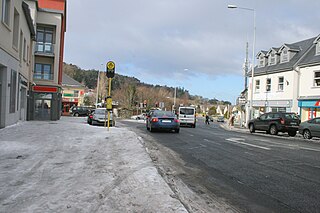
The Pale or the English Pale was the part of Ireland directly under the control of the English government in the Late Middle Ages. It had been reduced by the late 15th century to an area along the east coast stretching from Dalkey, south of Dublin, to the garrison town of Dundalk. The inland boundary went to Naas and Leixlip around the Earldom of Kildare, towards Trim and north towards Kells. In this district, many townlands have English or French names, the latter associated with Norman influence in England.

Trim Castle is a castle on the south bank of the River Boyne in Trim, County Meath, Ireland, with an area of 30,000 m2. Over a period of 30 years, it was built by Hugh de Lacy and his son Walter as the caput of the Lordship of Meath. The Irish Government currently own and are in charge of the care of the castle, through the state agency The Office of Public Works (OPW).

Roscrea is a market town in County Tipperary, Ireland, which in 2016 had a population of 5,446. Roscrea is one of the oldest towns in Ireland, having developed around the 7th century monastery of Saint Crónán of Roscrea, parts of which remain preserved today.

Swords Castle is an early medieval castle located in Swords, Dublin. Originally built for the Archbishops of Dublin in the early 13th century near the Ward River, some of the castle estate had fallen into disrepair by the 14th and 15th centuries. At least partially occupied through the 16th and 17th centuries, the castle was used as a place of rendezvous by Anglo-Irish Catholic families during the 1641 Rebellion. The site was afforded protection as a national monument and placed under the guardianship of the Office of Public Works in the early 20th century. As of the late 20th and early 21st century, the site was subject to a program of "long term phased restoration", and is partially opened for tours. The site is listed on Fingal County Council's Record of Protected Structures.

Stepaside is a village in the townland of Kilgobbin, on the southern edge of Dublin, in Dún Laoghaire–Rathdown, Ireland. The area is 4 kilometres (2.5 mi) south of Dundrum.

Newcastle is a village in County Wicklow, Ireland. It is situated on the R761 and is about 45 km (28 mi) south of Dublin city. Newcastle had a population of 924 as of the 2016 census. The ancient barony of Newcastle, which surrounds the village, takes its name from the village and its Norman castle.
The Black Dog was a prison in Newhall Market, now Cornmarket, in Dublin, Ireland. Built as a square tower and originally known as Browne's Castle, the site became a tavern and was in use as a prison from at least the 17th century. It was in use up until the late 18th century, when it was replaced by a number of new prisons, including Newgate Prison and a new Sheriff's Prison on Green Street.

Kilgobbin Cross is a high cross and National Monument located in Stepaside, County Dublin, Ireland.

Tully's Castle is a castle and a National Monument in Clondalkin, Ireland.

Slade Castle is a tower house and National Monument in County Wexford, Ireland. It is located in the village of Slade on the Hook Peninsula and primarily dates to the late 15th or early 16th century.

King John's Castle, also known as Carlingford Castle, is an enclosure castle and National Monument located in Carlingford, County Louth, Ireland.

Drishane Castle is a MacCarthy tower house and National Monument located in County Cork, Ireland. In modern times the name is also used to refer to the adjacent house which dates from the 18th century. It is located 2.2 km (1.4 mi) northeast of Millstreet, on the south bank of the Munster Blackwater.

Tallaght Castle was a castle in Kilnamanagh, Tallaght, County Dublin, Ireland. It dates from the 14th Century. It became an official residence of the Church of Ireland Archbishop of Dublin until 1822. It was taken over by the Dominican Order in 1856.

Ratass Church is a medieval church with ogham stone inscriptions in Tralee, County Kerry, Ireland. It is a National Monument.

Ballymalis Castle is a tower house and National Monument located in County Kerry, Ireland.

King John's Castle or King's Castle is a tower house and National Monument located in Kilmallock, Ireland.

Desmond Hall and Castle, also called Desmond Castle and Banqueting Hall or Newcastle West Medieval Complex and Desmond Hall, are a set of medieval buildings and National Monuments located in Newcastle West, Ireland. For over 200 years, it belonged to the Fitzgerald family, Earls of Desmond.
Rathdown Castle is a ruined castle and ancient settlement site located in County Wicklow, Ireland.
Reeves Castle is a 14th-century tower house (castle) located in County Kildare, Ireland. On the Record of Monuments and Places it bears the codes KD015-001 (enclosure) and KD015-002.

White's Castle is a 16th-century tower house in Athy, County Kildare, Ireland. Built on the site of an earlier 15th-century castle, White's Castle was built to guard the main river crossing in Athy and was extended over successive centuries.



















